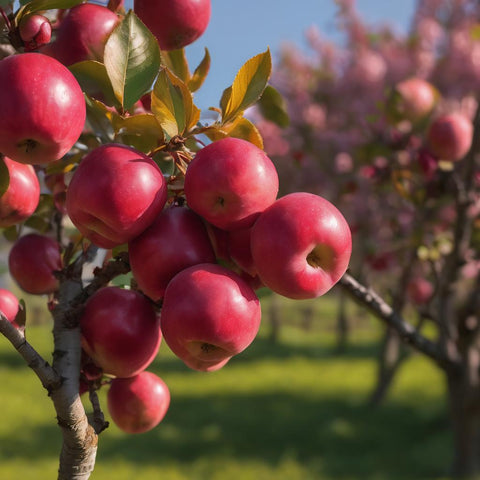Crabapple Tree:
Description:
- Crabapple trees are part of the Malus genus and are often cultivated for their ornamental value and attractive spring blossoms.
- They are deciduous trees that produce small, sour apples that are generally not consumed raw but are used in jams, jellies, and other culinary applications.
- Crabapple trees vary widely in size, shape, and color, with flowers ranging from white to pink and red.
Geographic Range:
- Crabapple trees are native to various temperate regions of Asia, Europe, and North America.
- They are widely cultivated as ornamental trees in gardens and landscapes, and many different cultivars and varieties exist.
Growing Conditions:
- Climate: Crabapple trees thrive in temperate climates with cold winters to fulfill their chilling requirements for proper fruit development.
- Soil: Well-drained soil is essential for crabapples. They can tolerate various soil types but prefer slightly acidic to neutral soil.
- Sunlight: Full sun is ideal for crabapple trees, promoting healthy growth and abundant flowering.
Caring for Crabapple Trees:
- Pruning: Regular pruning helps maintain a desirable shape, removes dead or diseased wood, and improves air circulation. Prune in late winter or early spring.
- Watering: While crabapples are generally adaptable and can tolerate periods of drought, regular watering during dry spells is beneficial, especially for young trees.
- Fertilization: Apply a balanced fertilizer in early spring to support healthy growth. Avoid excessive nitrogen, which can lead to excessive vegetative growth at the expense of flowering. The TreeHelp Crabapple Fertilizer is designed specifically to address the nutrient needs of the Crabapple tree.
Common Diseases and Pests:
- Apple Scab: A fungal disease that causes dark, scaly lesions on leaves, leading to defoliation. Fungicides such as Monterey Complete Disease Control and proper sanitation can help manage apple scab.
- Fire Blight: A bacterial disease that causes wilting, blackening, and a "burned" appearance on branches. Pruning infected branches and applying antibacterial sprays can help control fire blight.
- Cedar-Apple Rust: This fungal disease affects both crabapples and cedars. Orange lesions on leaves and fruit are common. Fungicides such as Monterey Complete Disease Control, or Liquid Copper and proper sanitation practices can help manage cedar-apple rust.
- Aphids and Spider Mites: These common pests can infest crabapple trees, causing distorted growth and discoloration. Insecticidal Soap or BugBuster II insect spray can be used for control.
Promoting the Overall Health of Your Tree
To bolster a tree's defense against diseases and insect invasions, it is important the prioritize its overall health to reduce susceptibility. Enhance your tree care routine by employing the TreeHelp Annual Care Kit for Crabapple Trees and adhering to a consistent, proper watering regimen.
Comprising three essential components, the TreeHelp Annual Care Kit focuses on ensuring the availability and effective uptake of proper nutrients. Inside, discover a custom formulated specialized fertilizer, mycorrhizal fungal treatment, and a green-up Biostimulant. The mycorrhizal treatment functions akin to bacteria in the human digestive system, breaking down nutrients and moisture into a form readily metabolized by the tree.
Recognize the significance of regular watering. Opt for less frequent, yet prolonged waterings when hydrating trees. The objective is to wet the entire root zone to a depth of 24 to 36 inches, not merely the surface. Unlike brief rains that only normally penetrate 5 to 6 inches of soil, leaving lower roots dry, a systematic watering program proves instrumental in sustaining urban trees. Embrace this comprehensive approach to fortify the vitality and overall health of your Crabapple tree.

